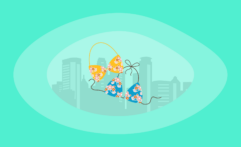12 Most Sustainable Jacket Brands: The Conscious Consumer’s Guide
Affiliate Disclosure
Hey fellow impactful ninja ?
You may have noticed that Impactful Ninja is all about providing helpful information to make a positive impact on the world and society. And that we love to link back to where we found all the information for each of our posts.
Most of these links are informational-based for you to check out their primary sources with one click.
But some of these links are so-called "affiliate links" to products that we recommend.
Why do we add these product links?
First and foremost, because we believe that they add value to you. For example, when we wrote a post about the environmental impact of long showers, we came across an EPA recommendation to use WaterSense showerheads. So we linked to where you can find them. Or, for many of our posts, we also link to our favorite books on that topic so that you can get a much more holistic overview than one single blog post could provide.
And when there is an affiliate program for these products, we sign up for it. For example, as Amazon Associates, we earn from qualifying purchases.
What do these affiliate links mean for you?
First, and most importantly, we still only recommend products that we believe add value for you.
When you buy something through one of our affiliate links, we may earn a small commission - but at no additional costs to you.
And when you buy something through a link that is not an affiliate link, we won’t receive any commission but we’ll still be happy to have helped you.
What do these affiliate links mean for us?
When we find products that we believe add value to you and the seller has an affiliate program, we sign up for it.
When you buy something through one of our affiliate links, we may earn a small commission (at no extra costs to you).
And at this point in time, all money is reinvested in sharing the most helpful content with you. This includes all operating costs for running this site and the content creation itself.
What does this mean for me personally?
You may have noticed by the way Impactful Ninja is operated that money is not the driving factor behind it. It is a passion project of mine and I love to share helpful information with you to make a positive impact on the world and society. However, it's a project in that I invest a lot of time and also quite some money.
Eventually, my dream is to one day turn this passion project into my full-time job and provide even more helpful information. But that's still a long time to go.
Stay impactful,
Amid growing concerns about the textile industry’s environmental impact, there is pressure to find greener clothes for your wardrobe, from underwear to outerwear. Unfortunately, fashion greenwashing makes it harder for you and all other consumers to figure out which clothing brands offer the most eco-friendly garments. So, we had to ask: Which are the most sustainable jacket brands?
The most sustainable jacket brands are Patagonia, BEDI, and culthread, which prioritize low-impact recycled materials, reduce carbon emissions, and give back to fight the climate crisis. In addition, Askov Finlayson and Tentree compensate for their climate impact in various ways.
Whether you are searching for a functional jacket for winter adventuring or some everyday urban outerwear without negatively impacting the soil, the water, the animals, and other people, there is a brand for you. So, let’s keep reading to learn more about the most sustainable jacket brands and how they ensure sustainable, ethical practices.
Here’s How We Selected the Most Sustainable Jacket Brands
The fast fashion industry has pushed for many clothing items, jackets included, to be trend-dependant and easily replaceable. Yet, the environmental impacts of making and landfilling clothes can be enormous, especially with certain materials.
“Sustainable: The ability to be maintained at a certain rate or level | Avoidance of the depletion of natural resources in order to maintain an ecological balance”
Oxford Dictionary
The brands on this list were chosen based on their commitment and actions to promote sustainable practices while reducing the environmental impacts of the textile industry.
They are transparent about their materials, processes, and workforce management within their supply chain.
Some brands focus their efforts on reducing waste and optimizing natural resources while others strive to reduce the carbon footprint of their clothes.
All of these brands share the commitment to reshape the textile industry toward a more sustainable and Earth-friendly sector.
These Are the 12 Most Sustainable Jacket Brands
Most Sustainable Jacket Brands
Overall, these jacket brands are sustainable. Yet, they take various approaches to reduce environmental impacts and uphold ethical standards. Let’s dive into each brand and find out more.
Patagonia: Everyday Wear for Those Who Care
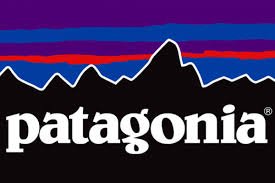
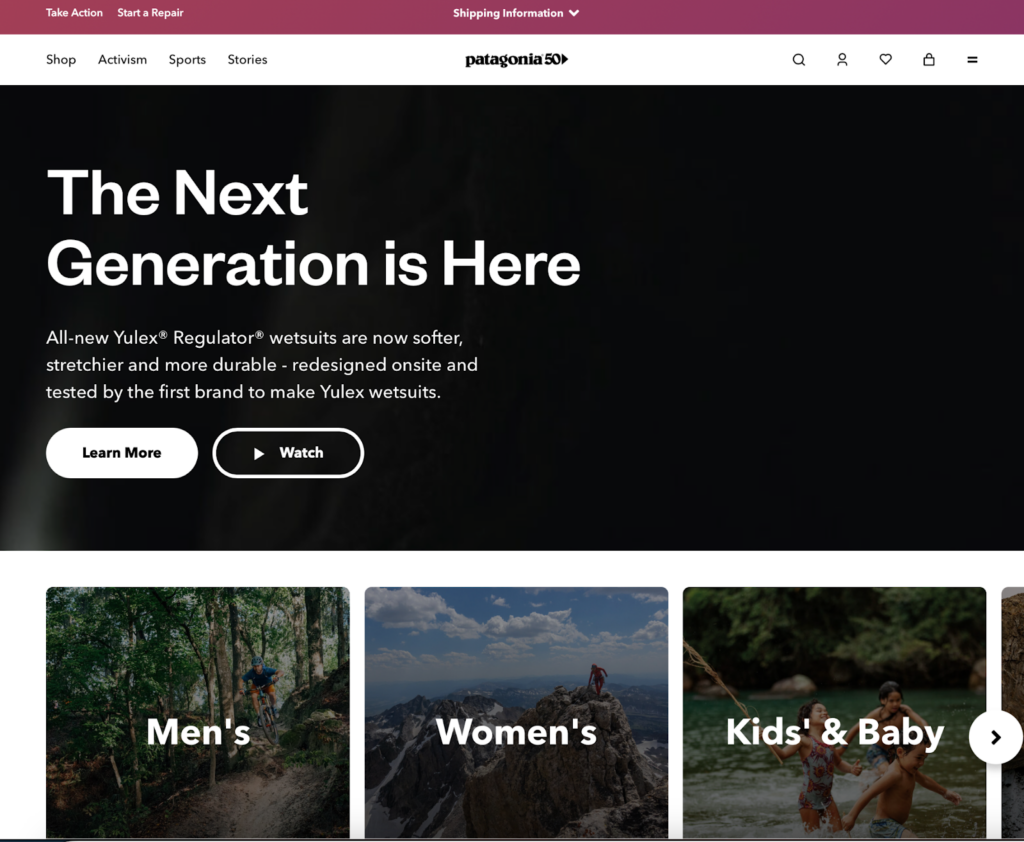
“Together, we can prioritize purpose over profit and protect this wondrous planet, our only home.”
Patagonia
🌎
How do they ensure their sustainability?
Patagonia puts sustainability at the center of their operation. They work to reduce, rather than simply offset, carbon emissions where it matters the most: in the supply chain and material manufacturing. They reduce their carbon footprint by removing high-impact virgin fossil-based fibers from their collections, using “Environmental Profit and Loss” to guide their production decision, and helping their suppliers to cut emissions. For example, Patagonia’s fall 2023 collection was made up mostly of preferred materials (91% by fabric weight), including Regenerative Organic Certified fibers, hemp, man-made cellulose fibers, recycled cotton, and recycled polyester. On top of that, Patagonia’s Worn Wear Program encourages customers to repair and recycle their products, extending the textile lifecycle and reducing waste. Lastly, Patagonia is certified as a B Corporation and a Bluesign® brand.
🌐
How do they ensure their ethics?
Patagonia commits to fair trade practices. Through the partnership with Fair Trade USA, they currently produce 86% of their clothes in 20 Fair Trade Certified™ factories. Patagonia pays a premium for every item produced in such factories, accumulating in a fund for workers to use in their chosen community projects, whether in healthcare or parent support or to withdraw as a cash bonus. Additionally, they have various social responsibility programs to prevent harm and create positive impacts on the lives of apparel workers in their supply chain. These include the Fair Labor Association, the Living Wage Program, the Migrant Workers Program, and the Responsible Purchasing Practices. Patagonia is also fully transparent about the locations of their facilities and suppliers.
🤝
Are they part of any giving-back programs?
Since 1985, Patagonia has pledged 1% of sales annually to environmental causes. They have awarded over $89 million in cash and kind donations to domestic and international grassroots environmental groups, making a difference in their local communities. In 2022, the founder of Patagonia gave away his family’s ownership of the company to the newly created Patagonia Purpose Trust and the not-for-profit organization Holdfast Collective, ensuring that all future profits from the company are used to fight the climate and extinction crisis.
🛍️
What is their product range?
- Best for: kidswear, menswear, womenswear
- Product range: shirts, pants, jackets, blazers, hoodies, sweatshirts, T-shirts, shorts, plus-size
- Price range: $$$
- Size range: XXS–XXXL
BEDI: Sleek Winter Jackets and Durable Bags From Recycled Materials


“Exceptionally sustainable materials and Canadian craftsmanship have resulted in a collection of utilitarian designs with impeccable detailing.”
BEDI
🌎
How do they ensure their sustainability?
BEDI ensures their sustainability by sourcing low-impact materials, minimizing waste, and reducing carbon emissions. Firstly, BEDI uses a high proportion of recycled and upcycled materials repurposed from various waste streams. These include ECONYL®, a 100% regenerated nylon fiber made from discarded fishing nets, premium leather salvaged from the furniture and aviation industries in Italy, car seat belts from scrap yards, deadstock weather-resistant twill taken from leftover outdoor furniture fabric, and recycled metal. Specifically, their OEKO-TEX®-certified ECONYL® materials, used in all their outerwear and approximately 48% of their bags, are highly water resistant, reducing the likelihood of microfiber releases. Additionally, BEDI opts for low-impact materials when it comes to virgin fabrics. Specifically, they use sustainably grown cotton, RWS-certified merino wool, and vegan leather made from cactus (Desserto®). Secondly, the brand takes many approaches beyond salvaging and upcycling existing materials to minimize waste. They employ technology to determine the optimal layouts to keep excess fabric as small as possible. In particular, small fabric scraps from cutting are used to make bag sections and keychains. Furthermore, they make everything in small batches, enabling real-time adjustments to minimize waste. And their efforts to reduce waste don’t stop when their products leave the store. In fact, BEDI offers a lifetime guarantee on all outerwear and bags with which they fix broken items for free, keeping them in circulation longer. Their “Second Life” program enables customers to return any BEDI products to be refurbished and resold. Lastly, BEDI keeps their carbon emissions low via manufacturing locally in Montreal, where 99% of electricity comes from renewable sources, making products by hand, transporting materials by boats, and shipping out orders with carbon-neutral shipping partners.
🌐
How do they ensure their ethics?
BEDI traces most of their suppliers and holds the final production stage in Canada, a low-risk country for labor abuse. They state that all BEDI employees and contractors are paid a living wage. They also share the makers of their products on their website.
🤝
Are they part of any giving-back programs?
BEDI is not known to be part of any giving-back programs.
🛍️
What is their product range?
- Best for: womenswear, menswear
- Product range: outerwear, knitwear, accessories
- Price range: $$$
- Size range: XS–3XL
culthread: Stylish and Comfortable Jackets From Vegan and Deadstock Materials

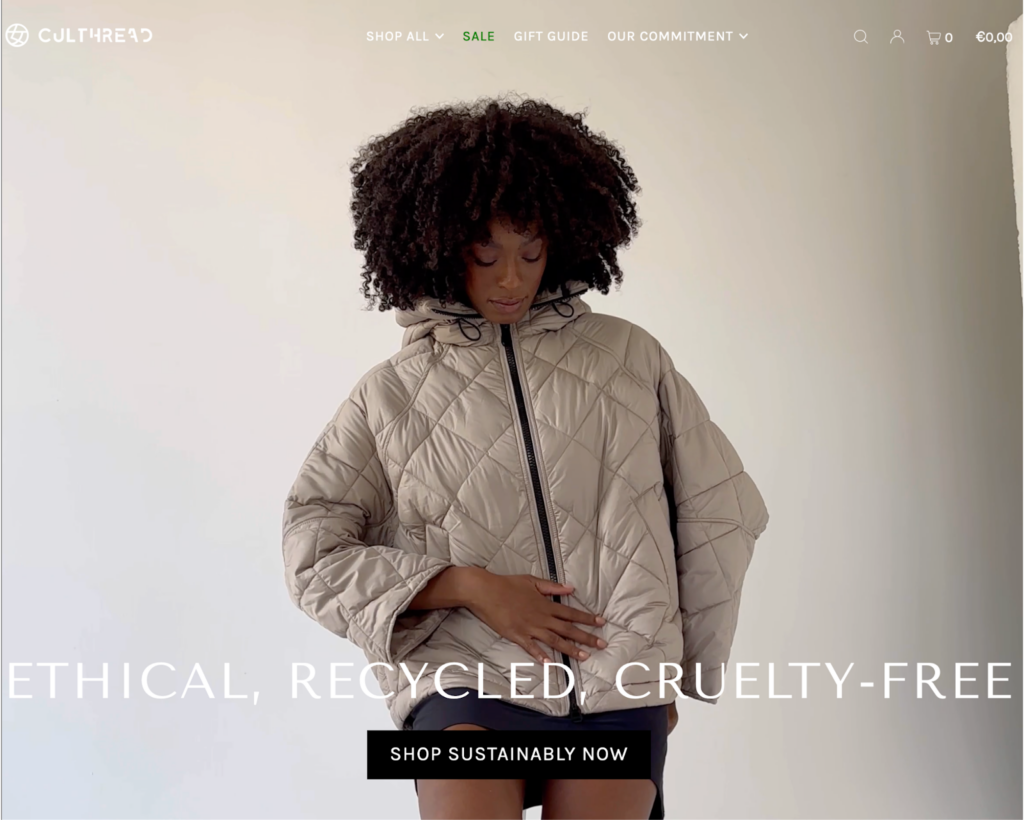
“I could not find a quality coat that aligned with my values, while also being stylish, practical and comfortable – despite working in the outerwear business for 15 years. I wanted a multi-pocket, hooded, 100% vegan, sustainable, lightweight, warm jacket. So I made my own.”
Rina, Founder of culthread
🌎
How do they ensure their sustainability?
culthread ensures sustainability by using a high proportion of low-impact textile and packaging materials, minimizing waste, and implementing incentives to reduce transport carbon footprint. At culthread, over 95% of jacket materials are vegan, recycled, or rescued. Specifically, they source Piñatex, 100% bio-based vegan leather, and recycled vegan leather made from coffee and bottle waste with water-based polyurethane (PU) coatings. Additionally, the polyester used for jacket fabrics, insulation, padding, and threads is 100% recycled with certifications from the Global Recycle Standard and OEKO-TEX® STANDARD 100. Regarding packaging, all their products come in a reusable “Destroy the Patriarchy not the Planet” laundry bag, made fully from production offcuts and deadstock. Beyond that, their mailer bags are biodegradable, recyclable, and plastic-free. The tape is also a fully biodegradable and 100% plastic-free self-adhesive paper packing tape. Furthermore, culthread minimizes waste by limiting production runs, optimizing fabric cutting using laser technology, and reusing old leftover material for new designs. Regarding transport carbon footprint reduction, the brand implements technology to reduce the back-and-forth of sample products at the design stage, while sourcing materials near where their factory is located. Lastly, they provide tips for customers to stay sustainable post-purchase by extending the lifespan of a product through caring, repairing, and donating.
🌐
How do they ensure their ethics?
culthread ensures their ethics by being transparent about their supply chain, including who their suppliers are and which certifications they hold. They have 100% traceability on their Tier 1 & 2 suppliers and visit their suppliers regularly. Furthermore, their partner suppliers are third-party audited, and their Supplier Code of Conduct covers ILO’s Four Fundamental Freedoms principles. Also, they pay tailors in their Vietnam-based factory aligned and above the Asia Living Wage and the Global Living Wage.
🤝
Are they part of any giving-back programs?
culthread supports various organizations, including Dress for Success Greater London, Crisis, Collective Aid, and Broken Shovels Farm Sanctuary.
🛍️
What is their product range?
- Best for: womenswear
- Product range: jackets, accessories
- Price range: $$
- Size range: XS–L
Askov Finlayson: Climate-Positive Winter Jackets


“We hold ourselves accountable for our carbon footprint each and every year and Give 110% to support leading-edge solutions to the climate crisis.”
Askov Finlayson
🌎
How do they ensure their sustainability?
Askov Finlayson ensures their sustainability by adopting a carbon-positive business model that enables the growth of their positive impact to outpace the growth of their carbon emissions. They achieve that by reducing their carbon emissions, calculating the dollar equivalent of their annual carbon footprint’s social cost, and compensating 110% of such climate cost with investment in leading organizations working to advance solutions to the climate crisis. Firstly, their emission reduction strategy starts with sourcing sustainable and recycled materials for their garments: their parkas use 100% recycled insulation materials and 100% recycled outer shell and lining fabrics. At the same time, their North hats are made exclusively from recycled yarns. Askov Finlayson also sells some organic cotton T-shirts and sweatshirts. Secondly, they compensate for their impact beyond merely offsetting their carbon emissions, but according to carbon emissions’ social cost that incorporates the human cost of climate change: extreme weather, sea level rise, food insecurity, and impact on public health. Lastly, their climate action investment pays 110% of such cost, ensuring they are climate-positive.
🌐
How do they ensure their ethics?
Askov Finlayson ensures their ethics by upholding all their supplies to a Supplier Code of Conduct, which bans all forms of forced labor, including child, indentured, and prison, as well as discrimination, harassment, or abuse of any kind. They state that their suppliers provide a healthy and safe workplace and pay a competitive wage with working hours that comply with local and national laws. Regarding animal welfare, they don’t use animal-derived down as insulation in their parkas and vests. Instead, the brand uses 3M™ Thinsulate™ 100% Recycled Featherless Insulation, avoiding the cruel treatment of animals widespread in fashion supply chains.
🤝
Are they part of any giving-back programs?
Askov Finlayson supports cutting-edge solutions to the climate crisis through their Give 110% grantmaking initiative, donating almost $1 million since 2015. As well, their Climate Pro Program makes Askov Finlayson products more accessible to those on the front lines of climate action.
🛍️
What is their product range?
- Best for: menswear, womenswear
- Product range: parkas, sweatshirts, T-shirts, accessories
- Price range: $$$
- Size range: XS–4XL
Tentree: A Lifestyle Clothing Brand That Plants Trees for Every Item Purchased

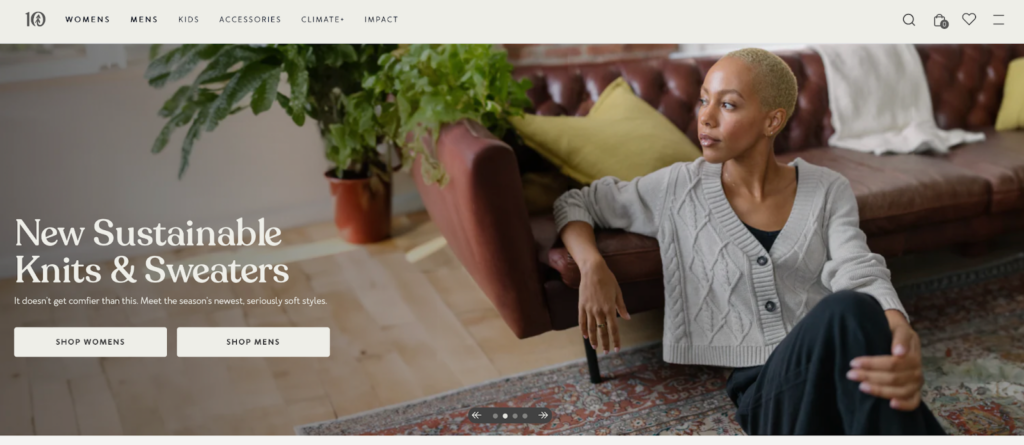
“ We believe the future of business is restorative.”
Tentree
🌎
How do they ensure their sustainability?
Tentree ensures sustainability by planting trees, promoting circularity, opting for low-impact fabrics, and attaining responsible packaging. Since their inception, they have planted more than 100,000,000 trees, which helps regenerate ecosystems, capture carbon, and provide forestry jobs in communities around the world. Together with textile recycler SuperCircle and resale guru Treet, Tentree has created an integrated solution to resell or recycle pre-loved Tentree clothing items, keeping them in circulation and out of landfills. Tentree also uses eco-friendly fabrics and blends, including organic cotton, hemp, recycled polyester, and TENCEL™. For example, the InMotion Tank is made with recycled polyester (REPREVE®) and is ideal for hitting the gym. Regarding packaging, they have replaced all single-use plastics with FSC-certified and 100% recycled paper. Finally, they have B Corporation and Climate Neutral certifications.
🌐
How do they ensure their ethics?
Tentree enforces fair labor practices by collaborating only with manufacturers and suppliers that guarantee a safe and respectful environment for their employees. They also regularly audit their partner facilities to ensure compliance with their Code of Conduct and international labor standards. Part of their supply chains is certified by organizations that protect workers, such as Fair Wear Foundation, Global Organic Textile Standard, Sedex Members Ethical Trade Audit, and Worldwide Responsible Accredited Production – WRAP. Additionally, Tentree commits to protecting forests through their paper, packaging, and fabric choices.
🤝
Are they part of any giving-back programs?
Giving back is a cornerstone of Tentree’s mission. Tentree plants 10 trees worldwide for every item purchased, contributing to reforestation and combating climate change. In 2022 alone, their customers helped plant over 22 million trees across nine countries, restoring over 2,000 hectares of terrestrial forests, over 1,000 hectares of coastal mangrove forests, and hundreds of hectares of marine land.
🛍️
What is their product range?
- Best for: kidswear, menswear, womenswear
- Product range: T-shirts, tank tops, shirts, sweaters, cardigans, dresses, pants, hoodies, dresses, shorts, skirts, joggers, jackets, coats, underwear
- Price range: $$
- Size range: XXS–XXL
Ecoalf: Spanish Clothing Brand Committing to Recycling Waste and Cleaning the Environment

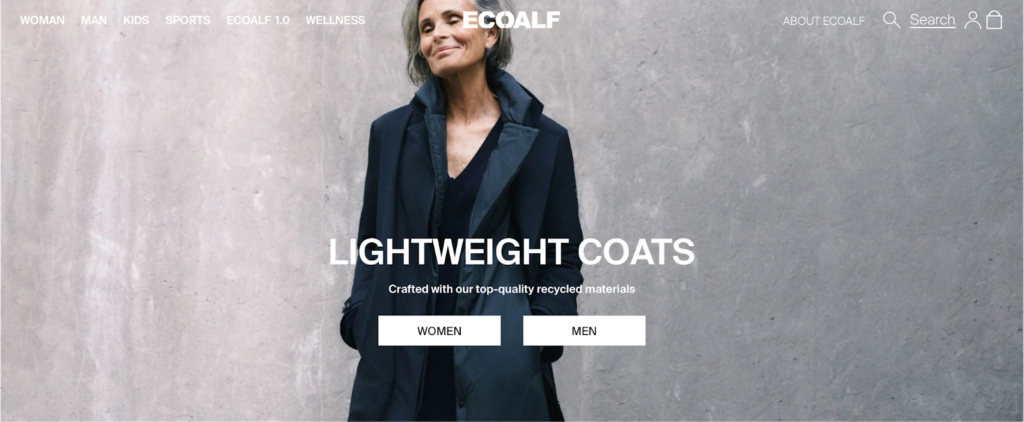
“I believe the time when fashion was just about looking good is over. More than ever it has to be about doing what is right and feeling good about it.”
Javier Goyeneche, founder of Ecoalf
🌎
How do they ensure their sustainability?
Ecoalf’s commitment to sustainability is evident in their innovative recycling practices. They minimize the use of natural resources by using mainly waste as raw materials, collecting and transforming discarded materials into recycled fabrics like recycled polyester, recycled cotton, recycled wool, and recycled cashmere. In 2023, they launched their first 100% recycled cotton collection that can be recycled again to achieve circularity. As well, in 2021, 74% of the materials used by Ecoalf were recovered from waste, saving 1,377 tons of CO2. In combination with. recycled fabrics, Ecoalf uses a small percentage of low-impact natural fabrics, such as linen and kapok. Ecoalf is also Bluesign® and B Corporation certified.
🌐
How do they ensure their ethics?
Ecoalf ensures their ethics by protecting their workers and the environment. In particular, they ensure there are safe and fair working conditions in their supply chain by mandating a Code of Conduct, an Equality Scheme, a Crime Prevention Handbook, a Disciplinary System, and a Bullying at Work Protocol. Additionally, they run many campaigns to raise awareness of the state of our oceans and earth-damaging consumerism habits.
🤝
Are they part of any giving-back programs?
Ecoalf actively participates in giving-back programs. The Ecoalf Foundation was founded to cleanse the oceans of marine waste with the help of the fishing industry while giving a second life to plastic waste through recycling and closing the loop. They achieve this through their “Upcycling the Oceans” projects. In 2021, Ecoalf donated 10% of all Because There’s No Planet B sales to the Ecoalf Foundation to expand the “Upcycling the Oceans” project beyond the Spanish border and into countries like Thailand, Greece, and France. The foundation also partners with Biotherm to set up the framework of “Limpia ríos, salva océanos”, a project supported by corporate volunteer days to collect waste and restore the environment. Additionally, Ecoalf’s employees volunteer in various environmental incentives.
🛍️
What is their product range?
- Best for: womenswear, menswear, kidswear
- Product range: shirts, pants, jackets, blazers, hoodies, sweatshirts, tops, blouses, knitwear, T-shirts, sneakers, accessories
- Price range: $$
- Size range: XS–XL
Cotopaxi: An Outdoor Brand Working to Alleviate Global Poverty


“To prioritize sustainability for both people and planet, we consider every phase of a product’s lifecycle, including partnering with factories that treat workers right, sourcing sustainably minded materials, and making durable gear that lasts.”
Cotopaxi
🌎
How do they ensure their sustainability?
Cotopaxi ensures sustainability by designing their products and sales orders in a way that creates as little waste as possible. In 2022, 98% of their products contained repurposed, recycled, or responsible materials. Cotopaxi’s eco-preferred fibers include recycled fibers (cotton, wool, cashmere, polyester, nylon), organic fibers (cotton, linen, hemp, silk), TENCELTM Lyocell, and wool that is certified to the Responsible Wool Standard. They also prioritize products that are timeless and durable while offering customers pathways to repair, resell, and return their products, promoting slow-fashion principles to avoid overconsumption and unnecessary waste. As of 2022, Cotopaxi has eliminated all single-use plastic packaging from their entire supply chain. Additionally, Cotopaxi monitors, measures, and reports on their material environmental impacts, including all greenhouse gas (GHG) emissions, to reduce and responsibly offset their entire carbon footprint. They also work with Pachama and BEF to purchase carbon offsets from verified and vetted projects. Last but not least, they request water usage measurement and water reduction targets from their Tier 1 and Tier 2 suppliers in order to reduce their overall water impact.
🌐
How do they ensure their ethics?
Cotopaxi has a Code of Conduct covering all of the ILO’s Fundamental Principles and Rights at Work. They also trace most of their supply chain and visit their suppliers regularly. Additionally, they ensure payment of a living wage in some of their supply chain.
🤝
Are they part of any giving-back programs?
Giving back is at the core of Cotopaxi’s operation. The Cotopaxi Foundation, founded in 2018, provides grants to nonprofits that help communities facing extreme poverty, including but not limited to organizations that provide healthcare, facilitate education, promote gender equality, and respond to humanitarian crises. Cotopaxi also became a member of 1% for the Planet in 2022, committing to donate 1% of sales to causes that support a healthier planet for all.
🛍️
What is their product range?
- Best for: menswear, womenswear, kidswear
- Product range: backpacks, travel bags, day bags, hip bags, bag accessories, jackets, vests, bottoms, T-shirts, hoodies, sweatshirts, activewear, accessories
- Price range: $$
- Size range: XS–3XL
Wuxly: Next-Gen Jackets Made With Innovative and Plant-Based Textile


“With only 1% of textiles being recycled worldwide, we’re working towards circularity, through up-cycling waste into high-performing outerwear and re-circulating older outwear to those in need with our Trade Up Program.”
Wuxly
🌎
How do they ensure their sustainability?
Wuxly ensures their sustainability by sourcing eco-friendly materials and striving for circularity. Firstly, they opt for high-performance materials that are recycled or bio-based. Their fabrics include bio-based performance fiber Sorona®, recycled nylon, and recycled polyester. Additionally, Wuxly sources exclusively from suppliers approved by Bluesign® and OEKO-TEX®. This means their materials are subject to the highest environmental standards and contain no harmful chemicals. Secondly, the brand strives for circularity by keeping materials in circulation longer and limiting textile waste from being sent to landfills. Specifically, their warranty and repair programs enable a longer lifespan for each garment while their Trade Up program cycles old outerwear back into the community to those in need. Wuxly also limits excess inventory thanks to a thoughtful production policy involving strategic forecasting and limited runs of styles. On top of that, they partner with other brands to create something new from their textile waste, such as the Cozy Clutch made from Wuxly’s 100% recycled polyester deadstock in partnership with ai.
🌐
How do they ensure their ethics?
Wuxly traces most of their suppliers and holds their final production stage in Canada, a low-risk country for labor abuse. Regarding animal welfare, their entire range is animal-free, avoiding the common cruel treatment subjected to animals in the fashion supply chain.
🤝
Are they part of any giving-back programs?
Wuxly funds a plastic collection across Ocean Co.‘s partner collection network, supporting projects that create the most impact for communities across the globe.
🛍️
What is their product range?
- Best for: menswear, womenswear, kidswear
- Product range: parkas, puffers, vests, bombers, raincoats, fleece, loungewear, accessories
- Price range: $$$
- Size range: S–XL
LANIUS: Premium-Quality Womenswear Advocating for Slow Fashion

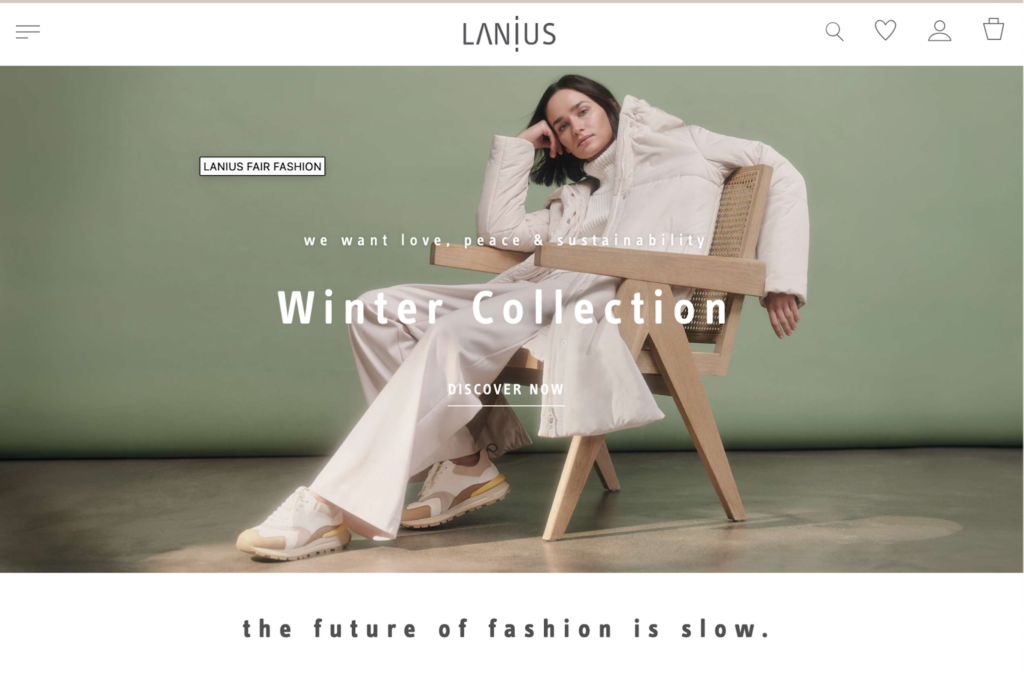
“For our textiles we use a whole variety of renewable raw materials, free of pesticides, herbicides and other poisons. ”
LANIUS
🌎
How do they ensure their sustainability?
LANIUS prioritizes sustainability by opting for a high proportion of eco-friendly materials, lowering the carbon footprint, and reducing waste by reusing some of their offcuts. They mainly use organic materials from controlled organic cultivation or from controlled organic animal husbandry, including GOTS-and OCS-certified organic cotton, hemp, linen, mulesing-free wool, and silk. Specifically, their velvet fabrics are made with GOTS-certified organic cotton, lowering the environmental impacts. Further down the life-cycle in the manufacturing stage, LANIUS uses low impact non-toxic dyes in most of their products while avoiding chemical high-grade finishing, such as anti-moth finishes, chlorine bleach or biocide finishes, resin, nickel, and Teflon. Regarding their carbon footprint, the brand implements various reduction measures like shortening the value chains to avoid unnecessary transport routes, using renewable energy in their supply chain, and shipping products in recycled cardboard boxes that are often reused several times. The unavoidable emissions are offset in reforestation and renewable energy projects in Asia. Lastly, in line with their dedication to slow fashion, LANIUS strives to extend the life of the clothes you and other consumers already own with their Care – Repair – Resell – Rent platform.
🌐
How do they ensure their ethics?
LANIUS traces most of their supply chain and discloses factories where their various finished products are manufactured. Their production partners have sustainability certificates such as the GOTS certificate, the BSCI Code of Conduct, and the SA8000 standard, and they are also audited by the Fair Wear Foundation. Additionally, LANIUS regularly visits their partners.
🤝
Are they part of any giving-back programs?
LANIUS is not known to be part of any giving-back programs.
🛍️
What is their product range?
- Best for: womenswear
- Product range: shirts, denim, sweaters, pants, hoodies, tops, blouses, T-shirts
- Price range: $$
- Size range: S–XL
Frank and Oak: Thoughtfully Design Clothing That Is Made to Last


“We design durable products that blend timeless style with functional features that help lay the foundation for better living.”
Frank and Oak
🌎
How do they ensure their sustainability?
Frank and Oak ensures sustainability by adopting circularity and innovation as their design philosophy. Firstly, they source innovative and circular materials for both garments and packaging. The garments are made with biodegradable bio-based fabrics—hemp, kapok, non-mulesed merino wool, traceable yak wool, SeaCellTM, and ECOVEROTM—and recycled fabrics, including recycled cotton, recycled polyester, recycled nylon, recycled wool, and Seawool. In particular, the brand has a Circular DenimTM collection, which is designed with repurposed materials and with the consideration for easy recycling at the end-of-life. They collect worn-out materials, break them into fibers, and weave the recycled fibers with new fibers (organic cotton) to ensure their denim fabrics’ structural integrity and durability. Their denim garments are also hydro-less, meaning their finishing treatments, including Ozone wash, nano-bubble technology, and 3D laser distressing, use as little as 5% of water conventionally used in manufacturing denim. The production of their hydro-less denim garment also uses up to 79% less energy and up to 50% fewer chemicals. Furthermore, Frank and Oak partners with Cotton’s Blue Jeans Go Green™ program to collect worn-out denim jeans and transform them into something new. Regarding packaging, Frank and Oak uses recycled and recyclable kraft boxes and mailers. On top of that, their compostable poly bags are made with a biodegradable polymer that allows microorganisms in landfills to break them down fully. Secondly, they design their garments for easy recycling by avoiding mixing too many fiber types in one garment. In 2023, over 70% of their styles were made using only one or two types of fibers. Frank and Oak also strives to reduce their carbon emissions by partnering with GoBolt to have their orders delivered in a carbon-neutral fashion. Also in 2023, GoBolt delivered 15% of their orders using Electric Vehicles and another 25% carbon-neutral via carbon offsetting.
🌐
How do they ensure their ethics?
Frank and Oak ensures their ethics by upholding all their manufacturing partners to their Code of Conduct and having them audited by international organizations such as BSCI (Business Social Compliance Initiative), WRAP (Worldwide Responsible Accredited Production), SMETA, and SA8000. They also share some of their partners and factories on their website.
🤝
Are they part of any giving-back programs?
Through their partnership with Town Brewery, Frank and Oak donates to the David Suzuki Foundation, which aims to protect Canada’s oceans and marine life biodiversity. Additionally, in the three years from 2021 to 2023, they funded the replanting of close to 70,000 sqm of land under their yak yarn supplier’s Grassland Regeneration Program.
🛍️
What is their product range?
- Best for: womenswear, menswear
- Product range: denim, pants, dresses, coats, jackets, T-shirts, tops, blouses, shirts, sweaters, cardigans, blazers, overshirts, accessories
- Price range: $$
- Size range: XS–XXL
TWOTHIRDS: An Ocean-Inspired Sustainable Clothing Brand


“We have a unique style that doesn’t look to please everybody but instead seeks those who crave depth, originality and of course sustainability in their clothing. We want to create garments that people will treasure.”
TWOTHIRDS
🌎
How do they ensure their sustainability?
TWOTHIRDS focuses their sustainability efforts on running a pre-order system to minimize overproduction while prioritizing organic, biodegradable, and recycled materials. They only produce what is ordered to prevent large, wasteful inventory. If a garment does not sell post-production, they turn the material into something else. They also use offcuts to make small production runs of tote bags, backpacks, or pencil cases. In addition to their small amount of deadstock offcuts, TWOTHIRDS sources deadstock yarns and fabrics from other local fashion brands to create their clothing items, like ocean-friendly knits or fleeces. Furthermore, they prioritized low-impact fabrics like organic cotton, linen, hemp, TENCELTM Lyocell, and LENZING™ ECOVERO™. Regarding their carbon footprint, TWOTHIRDS takes action to cut down their process emissions, including teaming up with research institutes, suppliers, and other organizations to improve their products’ sustainability performance, providing financial support for suppliers transitioning to green energy, and keeping the fabric and clothing production locally within Europe, while also sourcing some European original raw materials (such as Shetland wool and linen‘s flax).
🌎
How do they ensure their sustainability?
TWOTHIRDS traces most of their supply chain and visits their suppliers regularly. Both the fabric and clothes production stages happen in Europe, namely Austria, Portugal, France, and Italy, countries with relatively low risks for labor abuse.
🤝
Are they part of any giving-back programs?
TWOTHIRDS gives back to environmental causes, especially for the health of the world’s oceans. For example, during the Blue Week in November 2020, they donated €1 ($1.1) of every garment sold, in total €20,703 ($22,650), to WWF Spain’s ocean conservation initiatives.
🛍️
What is their product range?
- Best for: womenswear, menswear, kidswear
- Product range: T-shirts, shirts, swimwear, jackets, blazers, knitwear, tops, blouses, shorts, pants, dresses, jumpsuits, loungewear, activewear, underwear, accessories
- Price range: $$$
- Size range: XS–XXXL
Paka: Outdoor Garments Made With Traceable Alpaca Wool

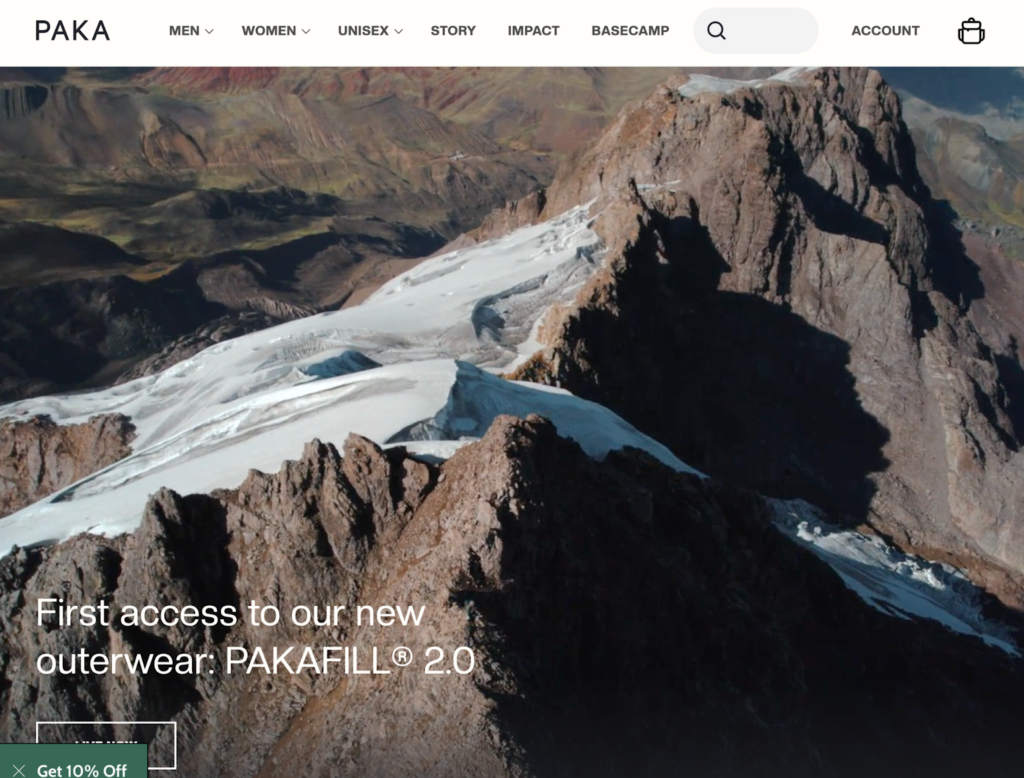
“Paka was created to bring you closer to where your clothing comes from, what it’s made of, and who made it.”
Paka
🌎
How do they ensure their sustainability?
Paka prioritizes sustainability by innovating and making low-impact, high-performing fabrics with ethical alpaca wool. In particular, they source alpaca wool from small-scale, family-owned herds. Each herd contains 60 to 90 animals roaming free throughout the Peruvian Andean Highlands. After the fleece is shorn, the fiber is collected and separated by hand before being colored (if needed) with environmentally friendly dyes certified by OEKO-TEX® and GOTS. Half of the energy used in their alpaca wool spinning process comes from solar energy. Further down the life-cycle in the transporting stage, Paka alpaca products are delivered carbon-neutral through their partnership with Ecocart. The packaging is also fully biodegradable.
🌐
How do they ensure their ethics?
Paka ensures their ethics by making their alpaca wool products fully traceable, from free-roaming alpacas up in the Andes Mountains to customers’ homes in the US. The 100+ Quechua women weavers who make Paka’s products are employed by the brand and paid 4 times the family living wage. Regarding alpaca treatment, Paka uses a special technique (Inca Esquila) to minimize the time and stress posed upon the animal during the shearing process.
🤝
Are they part of any giving-back programs?
Through their partnership with Peruvian Hearts, Paka supports the education of underprivileged Peruvian young women with 1% of their annual revenues. Another 1% of their sales supports regenerative agriculture and alpaca families. Additionally, they provide free weaving training for women who want to learn a skill, as well as a “Wawa Wasi” (daycare) in the neighborhood, with full-time supervision and a trained psychologist to enable mothers to go to work. Lastly, Paka is helping to build an NGO that preserves the Inca traditions.
🛍️
What is their product range?
- Best for: women’s and men’s knitwear
- Product range: jackets, sweaters, hoodies, baselayer, T-shirts, joggers, socks, underwear, accessories
- Price range: $$$
- Size range: XXS–XXL
Why Is It Important to Buy Products Made of More Sustainable Fabrics
It is important to buy products made of more sustainable fabrics because a sustainable textile industry has a lower carbon footprint, helps save natural resources, and is better for forests, animals, and humans.
Buying Sustainable Fabrics Reduces Your Carbon Footprint
The production of clothing and footwear is estimated to contribute 10% of global greenhouse gas emissions—more than all international flights and shipping combined. If the fashion industry were a country, it would be the fourth largest emitter of carbon dioxide.
One way to reduce the carbon footprint of the clothes you buy is to opt for sustainable fabrics. Sustainable fabrics, which are often made with natural or recycled fibers, have relatively low carbon footprints compared to petroleum-based fabrics. For example, organic cotton made in the US has a carbon footprint of 2.35 kg CO2 (per ton of spun fiber)—a quarter of polyester’s carbon footprint.
Buying Sustainable Fabrics Reduces Demand for Natural Resources and Waste Management
The textile industry uses water and land to grow cotton and other fibers. It is estimated that 79 billion cubic meters of water were used for the sector worldwide in 2015. For example, producing a single cotton T-shirt requires as much water as one person drinks for 2.5 years (2,700 liters of fresh water).
Worse yet, the textile economy is vastly more linear than circular: the largest amount of resources used in clothes ended up in landfill (instead of being recycled to remake clothes). According to a report by the Ellen MacArthur Foundation,
- Less than 3% of materials used in the textile economy in 2015 came from recycled sources.
- In other words, more than 97% of resources used in making clothes are newly extracted.
When clothing items are disposed of within a short period of time—under a year in the case of half of the fast fashion clothes—the natural systems that provide raw materials for fabrics don’t have enough time to recover and regenerate, which could lead to ecological breakdown.
Sustainable fabrics are made with less water and emissions while lasting longer:
- Because they are durable, you don’t need to buy new clothes too often.
- Thus, you help reduce the pressure to extract more resources for making new items.
Similarly, making and consuming sustainable fabrics made with recycled materials reduces the demand for virgin materials while helping tackle waste management.
Buying Sustainable Fabrics Encourages Sustainable Management of Forests
Sustainable natural fiber fabrics are made with raw materials from forests and plantations that are sustainably managed, such as complying with FSC standards.
When you buy sustainable natural fiber fabrics, you discourage unsustainable forestry practices like illegal logging. You can help reduce deforestation, biodiversity loss, and the effects of climate change.
Buying Sustainable Fabrics Encourages Fairer Treatment of Animals
The fashion industry is rife with animal mistreatment when it comes to making animal-based fabrics like wool or silk. Every year, billions of animals suffer and die for clothing and accessories.
Buying sustainable vegan alternatives can help to reduce the pressure on raising more and more animals to meet the demand for animal-based fabrics while sacrificing their well-being and lives.
Suppose you have to buy fabrics made with, for example, wool or silk; make sure you only choose brands committed to cruelty-free products. In that case, you help advocate better treatments for animals raised within the textile industry.
Using Sustainable Fabrics Encourages Fairer Treatment of Textile Workers
Recent statistics from UNICEF estimated as many as 170 million child laborers worldwide, many of whom were engaged in some form of work in the textile industry. They don’t get paid minimum wages and often work long hours.
When you buy sustainable fabrics from brands transparent about the working conditions at their factories, you discourage the use of child labor and help promote better working conditions for textile workers.
How Can You Generally Buy More Sustainable Fabrics
The key to sustainably buying fabrics is to check on relevant environmental and original certifications.
For natural fabrics:
- Global Organic Textile Standard (GOTS): A globally recognized certification system that ensures a certain threshold of organic content has been met. It covers manufacturing, packaging, labeling, transportation, and distribution (but not what happens in the fields where crops are grown).
- USDA Certified Biobased Product: The USDA BioPreferred® Certification is a voluntary certification offered by the United States Department of Agriculture. The certification identifies products made from plants or other renewable materials.
- Ecolabel: Ecolabel is the official Canadian Union voluntary label recognized worldwide for certified products with a guaranteed, independently verified low environmental impact. The label requires high environmental standards throughout the entire life-cycle: from raw material extraction through production and distribution to disposal. It also encourages companies to develop innovative, durable, easy-to-repair, and recyclable products.
For natural fiber semi-natural/semi-synthetic fabrics:
- Forest Stewardship Council: An FSC certification ensures that the wood (or wood-like material) comes from responsibly managed forests that provide environmental, social, and economic benefits.
There are two types of FSC Certification:- FSC Forest Management Certification, with a focus on the origin of the wood—the forest.
- FSC Chain of Custody Certification, which focuses on the path from the forest to the customer’s home.
- Program for Endorsement of Forest Certification: PEFC’s approaches to sustainable forest management are in line with protecting the forests globally and locally and making the certificate work for everyone. Getting a PEFC certification is strict enough to ensure the sustainable management of a forest is socially just, ecologically sound, and economically viable but attainable not only by big but small forest owners.
For recycled fabrics:
- Recycled Claim Standard (RCS): The Textile Exchange RCS was originally developed as an international, voluntary standard that sets requirements for third-party certification of Recycled input and chain of custody.
- The Global Recycled Standard (GRS): The Global Recycled Standard (GRS) is an international, voluntary, full product standard that sets requirements for third-party certification of Recycled Content, chain of custody, social and environmental practices, and chemical restrictions. It can be used for any product with more than 20% recycled material.
For all types of fabrics:
- STeP by OEKO-TEX®: STeP by OEKO-TEX® is an independent certification system for brands, retailers, and manufacturers from the textile and leather industry. It communicates organizational environmental measures, including reducing carbon footprint and water usage.
- OEKO-TEX® Standard 100: OEKO-TEX® labels aim to ensure that products pose no risk to human health (i.e., containing banned chemicals).
Some certifications that are signaling brands’ efforts toward lowered environmental impacts and a circular economy are:
- B Corp Certification: The label B Corp is a certification reserved for for-profit companies. Certified holders are assessed on their social and environmental impacts.
- Cradle2Cradle certification: Cradle2Cradle provides a standardized approach to material circularity. It assesses whether products have been suitably designed and made with the circular economy in mind covering five critical categories: material health, material reuse, renewable energy and carbon management, water stewardship, and social fairness.
Final Thoughts
The fast fashion industry has pushed for many clothing items, jackets included, to be trend-dependent and easily replaceable. Yet, the environmental impacts of making and landfilling clothes can be enormous, especially with certain materials. Thus, it is important to shop with ethics and sustainability in mind when choosing your next jacket.
By purchasing jackets from brands that commit to sustainability, you support their mission to create a fairer and less harmful textile industry for all lives on Earth.
Here is the list (again) of the most sustainable jacket brands:
- Patagonia
- BEDI
- culthread
- Askov Finlayson
- Tentree
- Ecoalf
- Cotopaxi
- Wuxly
- LANIUS
- Frank and Oak
- TWOTHIRDS
- Paka
To make your use of these jackets even more sustainable, follow these steps:
- Buy second-hand, recycled, or upcycled jackets made with low-impact materials.
- Keep your jackets for as long as possible.
- At the end-of-life of your jackets, upcycle the materials to extend their usage and arrange for them to be recycled or properly disposed of.
Stay impactful,

Sources
- Patagonia: Home
- BEDI: Home
- culthread: Home
- Askov Finlayson: Home
- Tentree: Home
- Ecoalf: Home
- Cotopaxi: Home
- Wuxly: Home
- LANIUS: Home
- Frank and Oak: Home
- TWOTHIRDS: Home
- Paka: Home
- Patagonia: Jackets & Vests
- Patagonia: The Climate Crisis Is Our Business
- Patagonia: The Climate Crisis Is Our Business | No More Virgin Petroleum Fibers by 2025
- Patagonia: The Climate Crisis Is Our Business | Is Each Product Worth the Environmental Cost?
- Patagonia: The Climate Crisis Is Our Business | Help Suppliers Cut Emissions
- Patagonia: Environmental Responsibility
- Patagonia: Regenerative Organic Certified fibers
- Patagonia: Hemp
- Patagonia: Man-made Cellulose Fibers
- Patagonia: Recycled Cotton
- Patagonia: Recycled Polyester
- Patagonia: WORN WEAR
- B Corporation: Patagonia
- Bluesign: Home
- Fair Trade: Home
- FAIR TRADE CERTIFIED: Improving Lives, Protecting the Planet.
- Patagonia: Social Responsibility
- Patagonia: Fair Trade
- Patagonia: Fair Labor Association
- Patagonia: Living Wage Program
- Patagonia: Migrant Workers Program
- Patagonia: Responsible Purchasing Practices
- Patagonia: Where We Do Business
- Patagonia: 1% for the Planet
- Forbes: Yvon Chouinard And The Patagonia Purpose Trust— What Is It And Will It Work?
- Fast Company: Patagonia uses capitalism to save the planet with the Holdfast Collective
- The New York Times: Patagonia Founder Gives Away the Company to Fight Climate Change
- B Corporation: BEDI
- BEDI: Men’s Winter Coats
- BEDI: Women’s Winter Coats
- Good On You: Brand Directory | BEDI
- Impactful Ninja: How Sustainable Are ECONYL® Fabrics? A Life-Cycle Analysis
- Impactful Ninja: How Sustainable Are Nylon Fabrics? A Life-Cycle Analysis
- BEDI: Our Materials
- Impactful Ninja: How Sustainable Are Leather Fabrics? A Life-Cycle Analysis
- OEKO-TEX: Home
- Impactful Ninja: How Sustainable Are Cotton Fabrics? A Life-Cycle Analysis
- Textile Exchange: Responsible Wool Standard
- Impactful Ninja: How Sustainable Are Merino Wool Fabrics? A Life-Cycle Analysis
- Impactful Ninja: How Sustainable Are Vegan Leather Fabrics? A Life-Cycle Analysis
- Desserto: Home
- BEDI: Sustainability
- BEDI: Second Life
- Canada Energy Regulator: Provincial and Territorial Energy Profiles — Quebec
- BEDI: Social Responsibility
- culhread: Jackets & Coats
- culhread: Sleeveless Puffer Jackets
- Good On You: Brand Directory | culthread
- culthread: Our Supply Chain
- Impactful Ninja: How Sustainable Are Piñatex Fabrics? A Life-Cycle Analysis
- Impactful Ninja: How Sustainable Are Polyurethane (PU) Fabrics? A Life-Cycle Analysis
- culthread: OUR PLANET | STYLE THAT RESPECTS OUR PLANET
- Textile Exchange: Global Recycled Standard
- OEKO-TEX: OEKO-TEX® STANDARD 100
- culthread: How to stay sustainable following a clothing purchase
- culthread: OUR PEOPLE
- Dress for Success Greater London: Home
- Crisis: Home
- Collective Aid: Home
- Broken Shovels Farm Sanctuary: Home
- Askov Finlayson: About Us
- B Corporation: Askov Finlayson
- Askov Finlayson: Men’s Winter Parkas
- Askov Finlayson: Women‘s Winter Parkas
- Askov Finlayson: 2022 Climate Impact Report
- Askov Finlayson: Mission
- Impactful Ninja: How Sustainable Are Organic Cotton Fabrics? A Life-Cycle Analysis
- Askov Finlayson: FAQs
- Askov Finlayson: Climate Pro Program
- Tentree: Sustainable Men’s Jackets, Coats, and Outerwear
- Tentree: Sustainable Women’s Jackets, Coats, and Outerwear
- Tentree: Tree Planting FAQ
- Tentree: Circularity By tentree
- Tentree: Our Materials
- Tentree: Thinking Outside the Box
- Tentree: WE’RE TENTRE | We Believe Big Change Starts Small.
- SuperCircle: Home
- Treet: Home
- Tentree: SuperCircle
- Impactful Ninja: How Sustainable Are Organic Cotton Fabrics? A Life-Cycle Analysis
- Impactful Ninja: How Sustainable Are Hemp Fabrics? A Life-Cycle Analysis
- Impactful Ninja: How Sustainable Are Recycled Polyester Fabrics? A Life-Cycle Analysis
- Impactful Ninja: How Sustainable Are TENCELTM Fabrics? A Life-Cycle Analysis
- Tentree: InMotion Tank | Recycled Materials
- REPREVE: Home
- Tentree: Eco-friendly socks
- Tentree: Responsible Packaging
- B Corporation: Tentree
- CLIMATE NEUTRAL: Tentree
- Tentree: Ethical Manufacturing
- Good On You: Brand Directory | Tentree
- Fair Wear Foundation: Home
- Sedex Members Ethical Trade Audit: Home
- Worldwide Responsible Accredited Production – WRAP: Home
- Shopify: Ten Tree International Inc. (tentree) | Commitment to Protect Forests Through Our Paper, Packaging and Fabrics Choices
- Tentree: THE ENVIRONMENTOR | Here’s Where We Plant Your Trees
- Tentree: 04 nature | TENTREE SUSTAINABILITY
- B Corporation: The Good Tee
- Ecoalf: Women’s Coats and Jackets
- Ecoalf: Men’s Coats and Jackets
- Ecoalf: Kds’s Coats and Jackets
- Ecoalf: Materials
- Ecoalf: History
- Ecoalf: DON’T THINK IT’S A UTOPIA | DISCOVER OUR 2021 SUSTAINABILITY REPORT
- Impactful Ninja: How Sustainable Are Recycled Fabrics? A Life-Cycle Analysis
- Impactful Ninja: How Sustainable Are Recycled Polyester Fabrics? A Life-Cycle Analysis
- Impactful Ninja: How Sustainable Are Recycled Cotton Fabrics? A Life-Cycle Analysis
- Impactful Ninja: How Sustainable Are Recycled Wool Fabrics? A Life-Cycle Analysis
- Impactful Ninja: How Sustainable Are Cashmere Fabrics? A Life-Cycle Analysis
- Ecoalf: History
- Ecoalf: Sustainable Report 2021 | DON’T THINK IT’S A UTOPIA
- Impactful Ninja: How Sustainable Are Natural Fabrics? A Life-Cycle Analysis
- Impactful Ninja: How Sustainable Are Linen Fabrics? A Life-Cycle Analysis
- Impactful Ninja: How Sustainable Are Kapok Fabrics? A Life-Cycle Analysis
- Bluesign®: Home
- B Corporation: Ecoalf
- Ecoalf: Code of Conduct
- Ecoalf: ECOALF foundation
- Ecoalf: Upcycling the Oceans
- Ecoalf: Because There’s No Planet B
- Ecoalf: Personas
- B Corporation: Cotopaxi
- Cotopaxi: Outerwear
- Cotopaxi: 2022 Impact Report
- Impactful Ninja: How Sustainable Are Recycled Fabrics? A Life-Cycle Analysis
- Impactful Ninja: How Sustainable Are Cotton Fabrics? A Life-Cycle Analysis
- Impactful Ninja: How Sustainable Are Wool Fabrics? A Life-Cycle Analysis
- Impactful Ninja: How Sustainable Are Cashmere Fabrics? A Life-Cycle Analysis
- Impactful Ninja: How Sustainable Are Polyester Fabrics? A Life-Cycle Analysis
- Impactful Ninja: How Sustainable Are Nylon Fabrics? A Life-Cycle Analysis
- Impactful Ninja: How Sustainable Are Organic Fabrics? A Life-Cycle Analysis
- Impactful Ninja: How Sustainable Are Linen Fabrics? A Life-Cycle Analysis
- Impactful Ninja: How Sustainable Are Hemp Fabrics? A Life-Cycle Analysis
- Impactful Ninja: How Sustainable Are Silk Fabrics? A Life-Cycle Analysis
- Impactful Ninja: How Sustainable Are TENCELTM Fabrics? A Life-Cycle Analysis
- Textile Exchange: Responsible Wool Standard
- Cotopaxi: Code of Conduct
- Good On You: Brand Directory | Cotopaxi
- International Labour Organization: Fundamental Principles and Rights at Work
- Cotopaxi: Our Impact
- Range of Motion Project: Home
- Fundación Escuela Nueva Volvamos a la Gente (FEN): Home
- Poverty Action Lab: Home
- International Rescue Committee: Home
- One Percent For The Planet: Home
- B-Corporation: Wuxly
- Wuxly: Our Materials
- Sorona: Home
- Impactful Ninja: How Sustainable Are Recycled Nylon Fabrics? A Life-Cycle Analysis
- Impactful Ninja: How Sustainable Are Recycled Polyester Fabrics? A Life-Cycle Analysis
- Wuxly: Warranty and Repairs
- Wuxly: Trade Up Program
- Wuxly: Our Commitment
- Wuxly: Cozy Clutch
- Good On You: Brand Directory | Wuxly
- LANIUS: Jackets
- Good On You: Brand Directory | LANIUS
- LANIUS: Our Standards | Sustainability at every level
- LANIUS: Cotton
- LANIUS: Hemp
- LANIUS: Linen
- LANIUS: Merino wool
- LANIUS: Silk
- LANIUS: CO2 Compensation
- Climate Partner: 7017
- LANIUS: Care – Repair – Resell – Rent
- LANIUS: Fair Production
- Global Organic Textile Standard (GOTS): Home
- AMFORI: BSCI
- SA International: SA8000
- Fair Wear Foundation: Home
- Frank and Oak: Women’s Jackets and Coats
- Frank and Oak: Men’s Jackets and Coats
- B Corporation: Frank and Oak
- Frank and Oak: Our Story
- Impactful Ninja: How Sustainable Are Hemp Fabrics? A Life-Cycle Analysis
- Impactful Ninja: How Sustainable Are Kapok Fabrics? A Life-Cycle Analysis
- Impactful Ninja: How Sustainable Are Merino Wool Fabrics? A Life-Cycle Analysis
- Impactful Ninja: How Sustainable Are ECOVEROTM Fabrics? A Life-Cycle Analysis
- Impactful Ninja: How Sustainable Are Recycled Fabrics? A Life-Cycle Analysis
- Impactful Ninja: How Sustainable Are Recycled Cotton Fabrics? A Life-Cycle Analysis
- Impactful Ninja: How Sustainable Are Recycled Polyester Fabrics? A Life-Cycle Analysis
- Impactful Ninja: How Sustainable Are Recycled Nylon Fabrics? A Life-Cycle Analysis
- Impactful Ninja: How Sustainable Are Recycled Wool Fabrics? A Life-Cycle Analysis
- Creative Tech Textile: Seawool
- Frank and Oak: Circular DenimTM
- Impactful Ninja: How Sustainable Are Organic Cotton Fabrics? A Life-Cycle Analysis
- Blue Jeans Go Green: Home
- Frank and Oak: Sustainable practices
- Frank and Oak: Impact Report 2023
- Frank and Oak: Factories
- Frank and Oak: Code of Conduct
- Amfori: BSCI
- WRAP Compliance: Home
- SEDEX: SMETA
- SA International: SA8000
- Frank and Oak: Brand Progress Report
- B Corporation: TWOTHIRDS
- TWOTHIRDS: Women’s Jackets
- TWOTHIRDS: Men’s Jackets
- TWOTHIRDS: We Are Eco
- Impactful Ninja: How Sustainable Are Organic Cotton Fabrics? A Life-Cycle Analysis
- Impactful Ninja: How Sustainable Are Linen Fabrics? A Life-Cycle Analysis
- Impactful Ninja: How Sustainable Are Hemp Fabrics? A Life-Cycle Analysis
- Impactful Ninja: How Sustainable Are TENCELTM Fabrics? A Life-Cycle Analysis
- TWOTHIRDS: Why You’ll Never Catch Us Using Viscose (With One Important Exception)
- Good On You: Brand Directory | TWOTHIRDS
- TWOTHIRDS: Find out more about TWOTHIRDS
- Impactful Ninja: How Sustainable Are Wool Fabrics? A Life-Cycle Analysis
- Good On You: Meet Ocean-Inspired Sustainable Brand TWOTHIRDS
- TWOTHIRDS: Into the Blue
- WWF Spain: Home
- B Corporation: Paka
- Paka: Apu Series
- Impactful Ninja: How Sustainable Are Alpaca Wool Fabrics? A Life-Cycle Analysis
- Paka: Alpaca Wool
- Paka: Traceable Alpaca Fiber
- OEKO TEX: Home
- Global Organic Textile Standard (GOTS): Home
- Paka: Earth
- Peruvian Hearts: Home
- Paka: Empowerment
- European Parliament: The impact of textile production and waste on the environment (infographic)
- Science Direct: The challenge of “Depeche Mode” in the fashion industry – Does the industry have the capacity to become sustainable through circular economic principles, a scoping review
- Science Direct: Carbon Footprint of Textile and Clothing Products
- European Parliament: Environmental impact of the textile and clothing industry
- European Parliament: What if fashion were good for the planet?
- Ellen MacArthur Foundation: A New Textiles Economy: Redesigning fashion’s future
- McKinsey: Style that’s sustainable: A new fast-fashion formula
- Forest Stewardship Council: Home
- Our World in Data: Deforestation and Forest Loss
- Our World in Data: Renewable Energy
- Peta: Animals Used For Clothing
- The Guardian: Child labour in the fashion supply chain
- Impactful Ninja: How Sustainable Are Natural Fabrics? A Life-Cycle Analysis
- Global Organic Textile Standard (GOTS): Home
- BioPreferred: WHAT IS THE BIOPREFERRED PROGRAM?
- European Commission: Environment | EU Ecolabel
- Impactful Ninja: How Sustainable Are Semi-Natural/Semi-Synthetic Fabrics? A Life-Cycle Analysis
- Forest Stewardship Council
- FSC Forest Management Certification
- FSC Chain of Custody Certification
- Textile Exchange: The RCS and GRS are designed to boost the use of recycled materials
- Program for Endorsement of Forest Certification
- Impactful Ninja: How Sustainable Are Recycled Fabrics? A Life-Cycle Analysis
- Textile Exchange: Recycled Claim Standard
- Textile Exchange: Global Recycled Standard
- OEKO-TEX: Certification according to STeP by OEKO-TEX®
- OEKO-TEX: STANDARD 100 by OEKO-TEX®
- B Corp Certification: Home
- C2CCertified: Home

